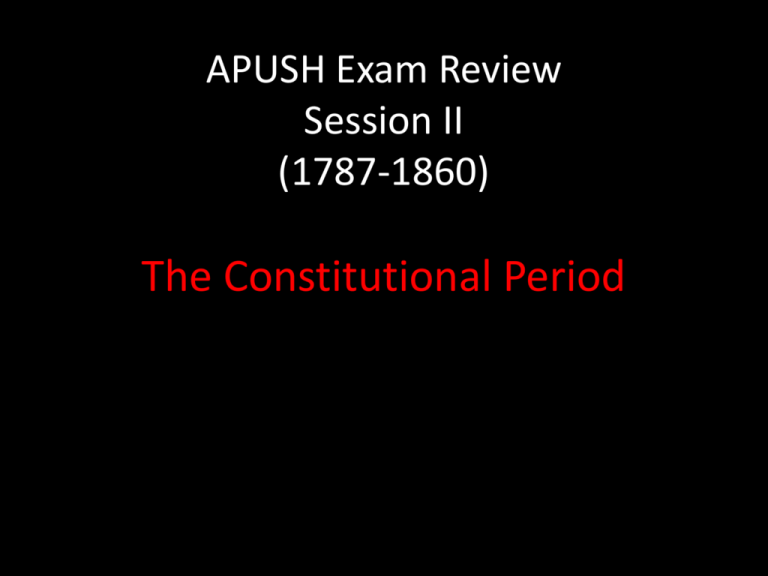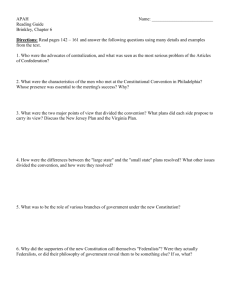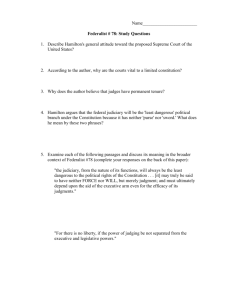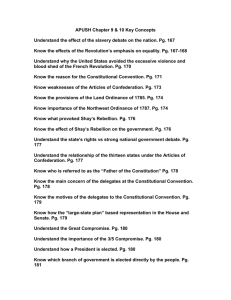APUSH Exam Review Session II (1787-1860)
advertisement

APUSH Exam Review Session II (1787-1860) The Constitutional Period Session II (1787-1860) Weaknesses of the Articles of Confederation: No power to tax and was limited to requesting funding from state govts. While the Confederation Congress (CC) could make laws, it had no power to enforce its decisions. The CC could not regulate trade between the states, many of which were creating international tensions with their different policies. There was no national court to settle differences like interstate commerce and boundary disputes over western territories. The CC could not raise an army and relied on the states for a militia for national defense. Session II (1787-1860) Accomplishments of the Articles of Confederation: Winning the Revolutionary War – especially successful with diplomacy. Land Ordinance (1785) & Northwest Ordinance (1787) Established public policy for western lands Established policy for setting aside one section of land in each township for public education Established laws that set rules for creating new states. *When requirements were met for statehood, new states were admitted as equals into the American Republic. Session II (1787-1860) State Constitutions – The experiments of the new American states in constitution making provided invaluable experience that would later influence the formation of the US Constitution. Six principles found in these documents were: 1. Higher Law & Natural Rights 2. Social Contract 3. Popular Sovereignty 4. Representative Government & Right to Vote 5. Legislative Supremacy 6. Separation of Power between legislative, executive, and judicial branches. Session II (1787-1860) The Model from Massachusetts: Written in 1780 by John Adams Made extensive use of separations of powers and checks & balances Governor to be elected by the people Had power to veto laws passed by the legislature Appoint officials to executive branch and judges in the judicial branch *The Massachusetts state constitution expressed the classical republican ideal of mixed government as a means to prevent the abuse of power by any member or group in government. Session II (1787-1860) Post War Problems: Post-war economic recession and reorganization outside the British system. Reluctance by some states to address their state debts and financial obligations. (war debts, Loyalists settlements, prewar debts to Britain) *Because of this, Britain will maintain forts along the western frontier. Lack of uniformity and standardization in interstate trade. Increasingly volatile foreign trade. Increasing importance of New Orleans. Session II (1787-1860) The Road to the Constitutional Convention: 1786 – Annapolis Convention (Reps from 5 states met to discuss conflicts between the states over trade & boundary disputes. Call for a meeting the following year in Philadelphia to revise the Articles of Confederation.) 1786 – Shays’s Rebellion (Rebellion by farmers in Massachusetts protesting state taxes. The national govt has no power to quell this rebellion.) 1787 – Federal Convention (55 delegates from 12 states met in Philadelphia to revise the AofC.) Session II (1787-1860) Highlights from the Constitutional Convention: Debate over representation in the national legislature The Virginia Plan – generally favored by states with large populations The New Jersey Plan – favored by states with small populations The Connecticut or Great Compromise – created a bicameral legislature with representation in the lower House based on population and elected directly by the peopole; and the upper chamber (Senate) based on equal representation. Senators to be elected by state legislatures. • All bills for taxing and government spending would originate in the House of Representatives. Direct taxes were to be assigned and divided (apportioned) among the states by population. Session II (1787-1860) The Compromise over Slavery: A number of slave states threatened not to ratify the new Constitution if there were any attempt to interfere with slavery. The Three-Fifths Compromise was agreed to where by every five slaves would constitute three people when the state’s apportionment to the House of Reps was determined. The importation of slaves would continue for 20 years. In 1808, the importation of slaves was set to be abolished. An agreement provided for the return of runaway slaves. Session II (1787-1860) Post War Political Situation: Articles of Confederation (1777-1789) First written constitution for the United States Reflected the prevailing fear of abuse from a distant, strong central government AofC created a weak national government with a unicameral legislature, no executive or judicial branches In this unicameral legislature, each state would have one vote and a unanimous vote was required to pass legislation The most important powers were retained by the states Session II (1787-1860) The New Executive Branch: Many feared the creation of a strong executive. The new president was to be elected for four-year terms. Citizens would not vote directly for the president (FF fear of too much democracy might lead to mob rule). Voter will would be expressed by an Electoral College, which would act as an insulating layer between the people and the president. The Judicial Branch: To better ensure an independent federal judiciary, judges were to be appointed for life by the president and confirmed by the Senate. Session II (1787-1860) Amending the New Constitution: Wanting to make it difficult, but not impossible, the new Constitution provided for the following Amendment process: Amendments are proposed by two-thirds of Congress or by a special convention called by two-thirds of the state legislatures. Amendments must then be ratified by threefourths of the states acting through their state legislatures or via a special state convention. Session II (1787-1860) The Ratification Debate: Federalists vs. Anti-Federalists Anti-Federalists: The new Constitution… gave too much power to the national govt at the expense of state govts; gave too much power to the executive branch, which would be a potential threat to the republic; did not adequately separate the powers of the executive and legislative branches allowed for the national govt to keep an army during peace time and the executive was to be the commander-in-chief; made no provision for a bill of rights. Session II (1787-1860) The Ratification Debate: Federalists vs. Anti-Federalists The campaign for ratification in New York was the focal point for Federalist forces: Federalist advocates Alexander Hamilton, James Madison, and John Jay wrote a series of essays published in the NY newspapers. These Federalist Papers became the most important defense of the Constitution. Federalists were able to convince enough people to support the Constitution with these arguments: the organization of the new federal govt would prevent abuse and tyranny via a complicated system of representation, checks and balances, and the separation of powers The representation of different interests in the govt would protect basic rights: House of Reps – local interests, Senate – state interests, Executive – national interests, Judicial – fundamental ineterests Federalists ultimately agree to a Bill of Rights to ensure ratification of the Constitution. Session II (1787-1860) Washington Administration: George Washington elected president in 1789 Congress created three executive departments to aid and advise the new president: Secretary of the Treasury - Alexander Hamilton Secretary of State – Thomas Jefferson Secretary of War – Henry Knox Attorney General – Edmund Randolph Washington appointed John Jay as the nation’s first Chief Justice of the Supreme Court Session II (1787-1860) Hamilton’s Financial Plans: In his 1790 Report on the Public Credit, Hamilton wanted to: pay off the national debt and have the Federal Government assume the debts of the states he proposed offering the holders of this debts new govt securities that would pay interest payments of 4% this “funded” debt would be paid for with import tariffs Hamilton’s hope was that wealthy American/foreign investors would buy up the federally backed securities and have a vested interest in the political future of the nation *To accomplish this, Hamilton compromised with Jefferson & Madison, the emerging leaders of the faction opposing Hamilton’s plans, on the location of the federal capital. (New York > Philadelphia > Washington, DC) Session II (1787-1860) Hamilton’s Financial Plans: Hamilton proposed a tariff to protect fledgling US industries; rates were raised only slightly after the House, led by Madison, feared Euro retaliation against Southern exports. Hamilton advocated for the creation of a National Bank modeled on the Bank of England. Hamilton’s Report on Manufacturers called for additional customs duties, an excise or “sin” tax on distilled liquors, the rapid sale of western lands, and federal stimulus of domestic industrial production via tax subsidies and tax breaks.




